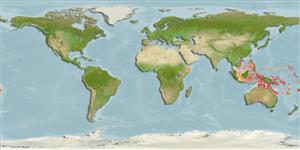Teleostei (teleosts) >
Gobiiformes (Gobies) >
Gobiidae (Gobies) > Gobiinae
Etymology: Signigobius: Name from Latin, signus for mark and gobius for a genus of fish, referring to its distinctive coloration; biocellatus: Name from Latin bi meaning two and ocellatus for small eye spots, referring to the 2 prominent ocellated spots on the dorsal fins.
More on authors: Hoese & Allen.
Environment: milieu / climate zone / depth range / distribution range
Ecology
Marine; reef-associated; depth range 1 - 30 m (Ref. 1602), usually 2 - 30 m (Ref. 27115). Tropical; 22°C - 27°C (Ref. 27115); 19°N - 24°S
Western Pacific: Philippines to the Solomon Islands and Vanuatu, south to the southern Great Barrier Reef; Palau in Micronesia.
Size / Weight / Age
Maturity: Lm ? range ? - ? cm
Max length : 10.0 cm SL male/unsexed; (Ref. 48637)
Dorsal spines (total): 7; Dorsal soft rays (total): 10 - 11; Anal spines: 1; Anal soft rays: 10 - 11. Conspicuous ocellated dorsal fins (Ref. 90102); characterized by pale bluish grey to yellowish tan; narrow brown bar below eye; upper half of body with irregular brown spot and saddles; three irregular brown bars on lower half of body; narrow brown bar across base of caudal fin; pelvic and anal fins black with blue spots; rounded caudal fin; longitudinal scale series 48-55; mainly ctenoid body scales posteriorly, becoming cycloid anteriorly just behind pectoral base and below first dorsal fin; cycloid on ventral surface of abdomen; head and midline of nape without scales; depth of body 4.3-5.6 in SL (Ref. 90102).
Adults occur in sandy to silty bottoms of lagoons and coastal bays near coral, rubble or leaf litter shelter. Solitary or in pairs that share sandy burrows (Ref. 90102). Feed on small interstitial invertebrates by sifting mouthfuls of sand. Monogamous (Ref. 52884, 48637).
Life cycle and mating behavior
Maturity | Reproduction | Spawning | Eggs | Fecundity | Larvae
Monogamous mating is observed as both obligate and social (Ref. 52884).
Allen, G.R. and R. Swainston, 1992. Reef fishes of New Guinea: a field guide for divers, anglers and naturalists. Publication No. 8. Christensen Research Institute, Madang, Papua New Guinea. 132 p. (Ref. 6023)
IUCN Red List Status (Ref. 130435: Version 2024-1)
Threat to humans
Harmless
Human uses
Fisheries: of no interest; aquarium: commercial
Tools
Special reports
Download XML
Internet sources
Estimates based on models
Preferred temperature (Ref.
123201): 25.8 - 28.9, mean 27.7 °C (based on 350 cells).
Phylogenetic diversity index (Ref.
82804): PD
50 = 1.0000 [Uniqueness, from 0.5 = low to 2.0 = high].
Bayesian length-weight: a=0.01023 (0.00477 - 0.02194), b=3.01 (2.83 - 3.19), in cm total length, based on LWR estimates for this (Sub)family-body shape (Ref.
93245).
Trophic level (Ref.
69278): 3.5 ±0.37 se; based on food items.
Resilience (Ref.
120179): High, minimum population doubling time less than 15 months (Preliminary K or Fecundity.).
Fishing Vulnerability (Ref.
59153): Low vulnerability (10 of 100).
Nutrients (Ref.
124155): Calcium = 108 [58, 218] mg/100g; Iron = 0.771 [0.403, 1.406] mg/100g; Protein = 18.5 [16.7, 20.2] %; Omega3 = 0.157 [0.071, 0.270] g/100g; Selenium = 21.2 [11.4, 41.4] μg/100g; VitaminA = 149 [43, 452] μg/100g; Zinc = 1.79 [1.21, 2.64] mg/100g (wet weight);
